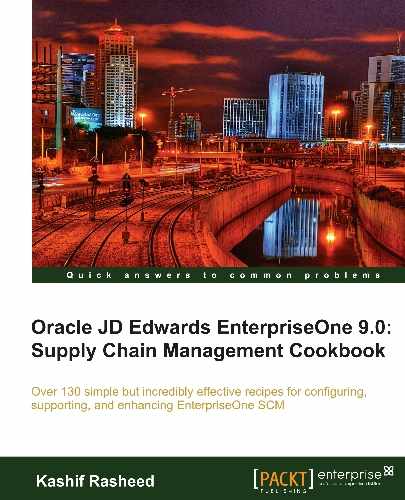This recipe demonstrates order hold information, and discusses how to enter order hold information.
- Enter a Hold Code from the Hold Codes (40/HC) UDC table to specify why an order is placed on hold.

- In the Person Responsible field, enter the address book number of the person who is responsible for reviewing and releasing orders placed on hold.
- Enter a Limit Type value from the Limit Type (42/LM) UDC table to specify the type of value the system validates. For example, you might enter a value to specify an amount or a percentage.
- Enter a Code Type from the Code Type (42/TC) UDC table to specify the hold code that applies at the order level. For credit holds, the hold code applies to the whole order. Procurement holds do not support line level-holds.
- Enter a value from the Aging Period (H40/AP) UDC table to specify the aging period that the system uses when you specify a credit check based on the aging of the customer's accounts receivable.
- Enter the allowable percentage in the Allowable % field that informs the system of the percentage of total receivables to accept in the column specified in the Age From field. You must complete the Allowable % field when aging credit checking is used. For example, if the customer has a total accounts receivable balance of $10,000 with $2,500 of that in the 31-60 day column, the age from value is 3 (31-60 days) and the acceptable percent value is 10 (10%). Therefore, this customer could have as much as $1,000 (10,000 x 10%) in columns 3 through 6 and still pass this credit checks. If the customer has more, the system will place the customer's orders on hold.
- Enter the Upper Limit amount that the system uses as the high end of the range of acceptable margin percentages or amounts. Complete this field when you want to establish a maximum gross margin percentage, or an amount for an order or individual order line.
- Enter the Lower Limit amount that the system uses as the low end of the range of acceptable margin percentages or amounts. Complete this field when you want to establish a maximum gross margin percentage, or an amount for an order or individual order line.
- Enter the Password that the system requires before it releases a held order. Only users with access to the password can release the order. Do not enter blanks anywhere in the password.
You can put an order on hold to prevent it from being processed. When you assign a hold code to an order, the system does not allow the order to be processed until you release the hold. You must set up the individual hold codes that you intend to assign to orders. Each hold code can identify a certain type of hold. For example, you might set up a hold code to identify orders that exceed budget. There are also administrative holds and approval holds. You might set up another hold code to identify orders that exceed the maximum order amount. There are also predefined system-assigned hold codes. The system will automatically assign budget holds to orders if you set the processing options for the Purchase Orders program (P4310) accordingly. The system automatically assigns approval holds after you have set the processing options for the Purchase Orders program (P4310) accordingly and the order is awaiting approval. The system also assigns a hold code to an order if you have entered a hold code for the supplier. You can specify the person who is responsible for reviewing and releasing a certain type of order hold. You must specify a password for each hold code. Only those individuals who know the password can release an order to which the hold code is assigned.
Procurement holds must be set up at the order level. Procurement does not support line-level holds.
- Setting up purchase orders in Chapter 4,Understanding and Setting up Procurement
